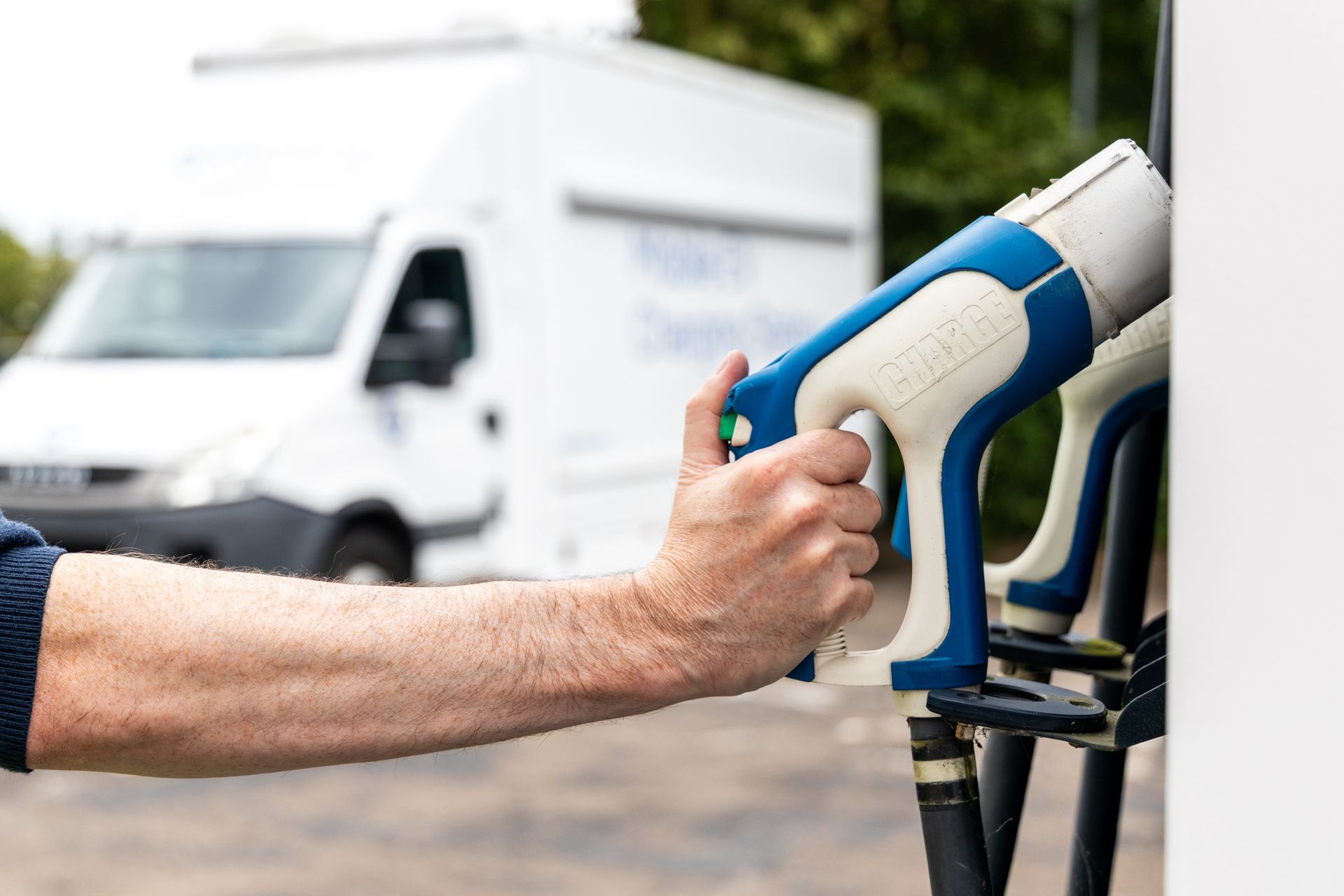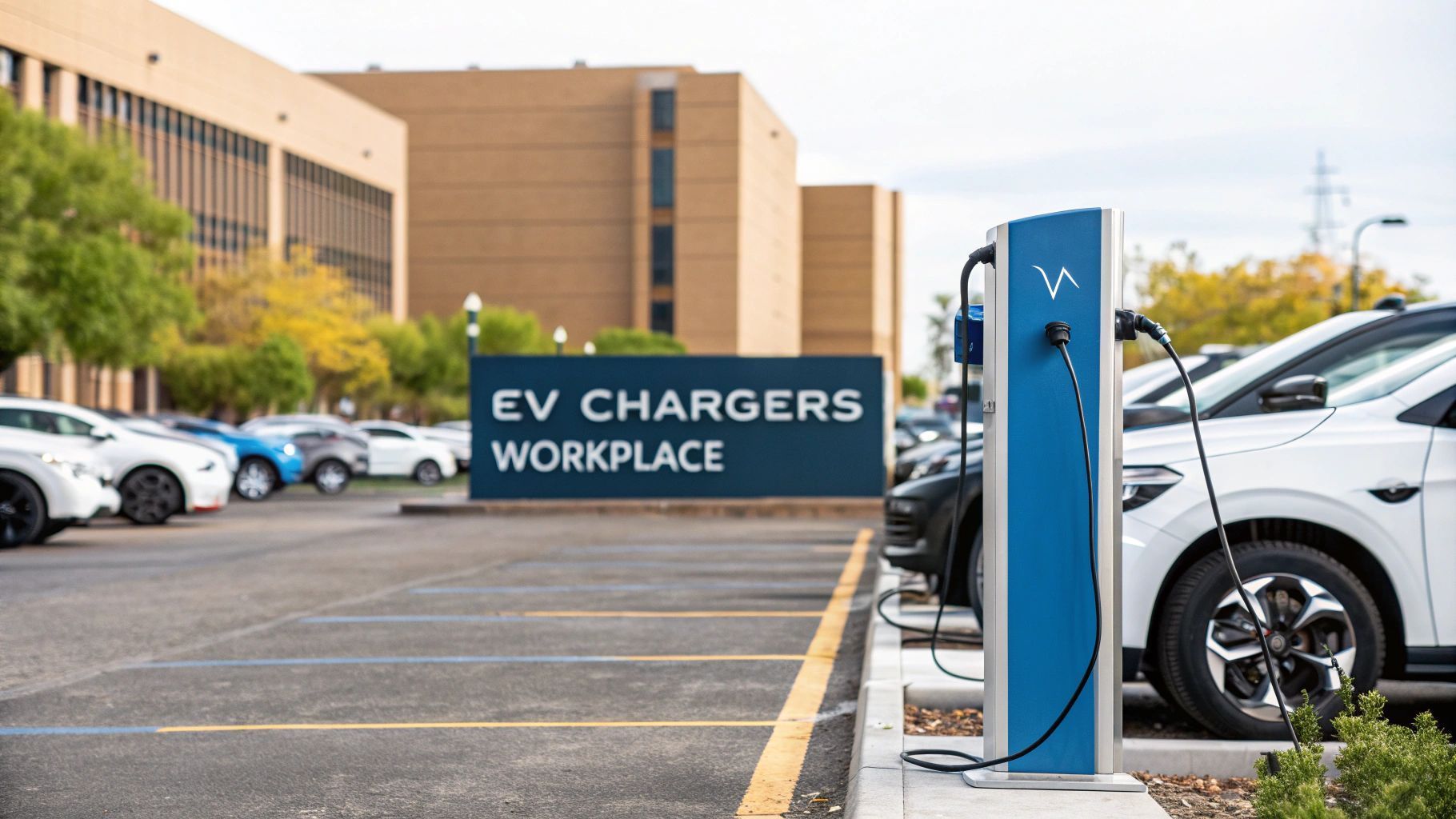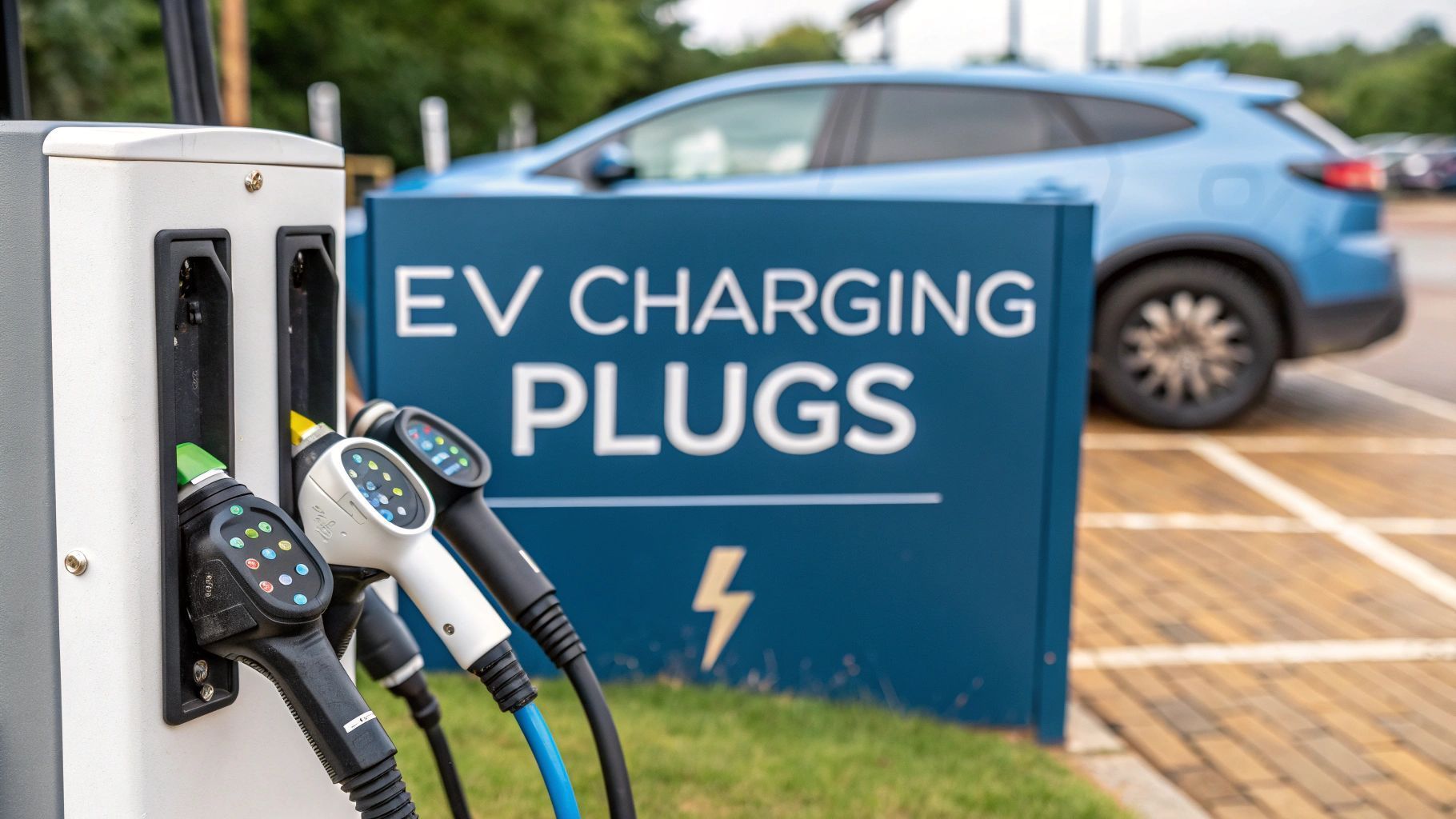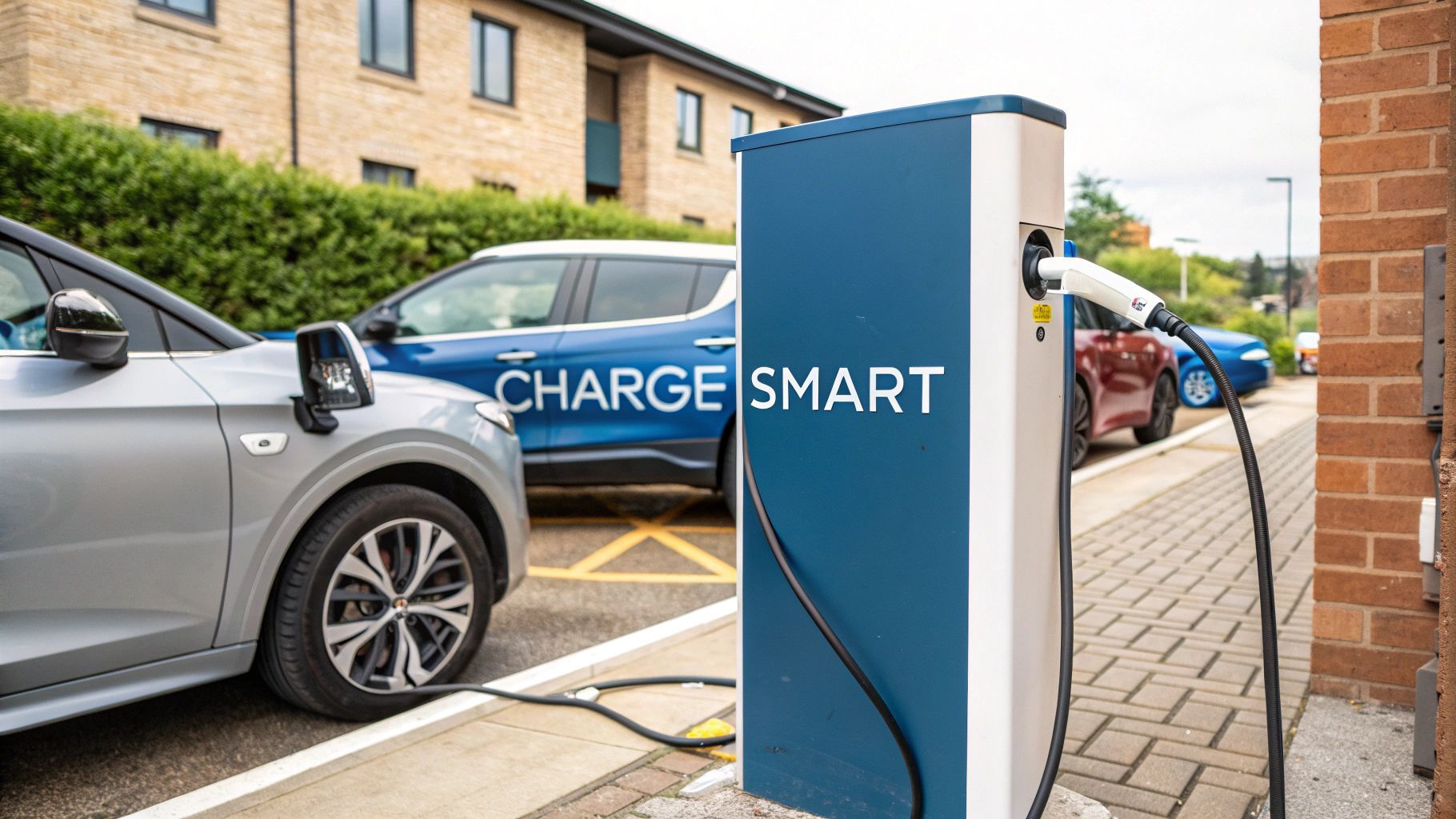Workplace Electric Vehicle Charging: Your Ultimate Guide
Thinking about adding workplace electric vehicle charging ? It’s no longer a nice-to-have perk but is fast becoming a business essential here in the UK. As the country shifts gears towards electric transport, offering on-site charging gives you a serious competitive edge, aligning your business with what modern employees and clients expect.
Why Workplace EV Charging Is a Smart Move
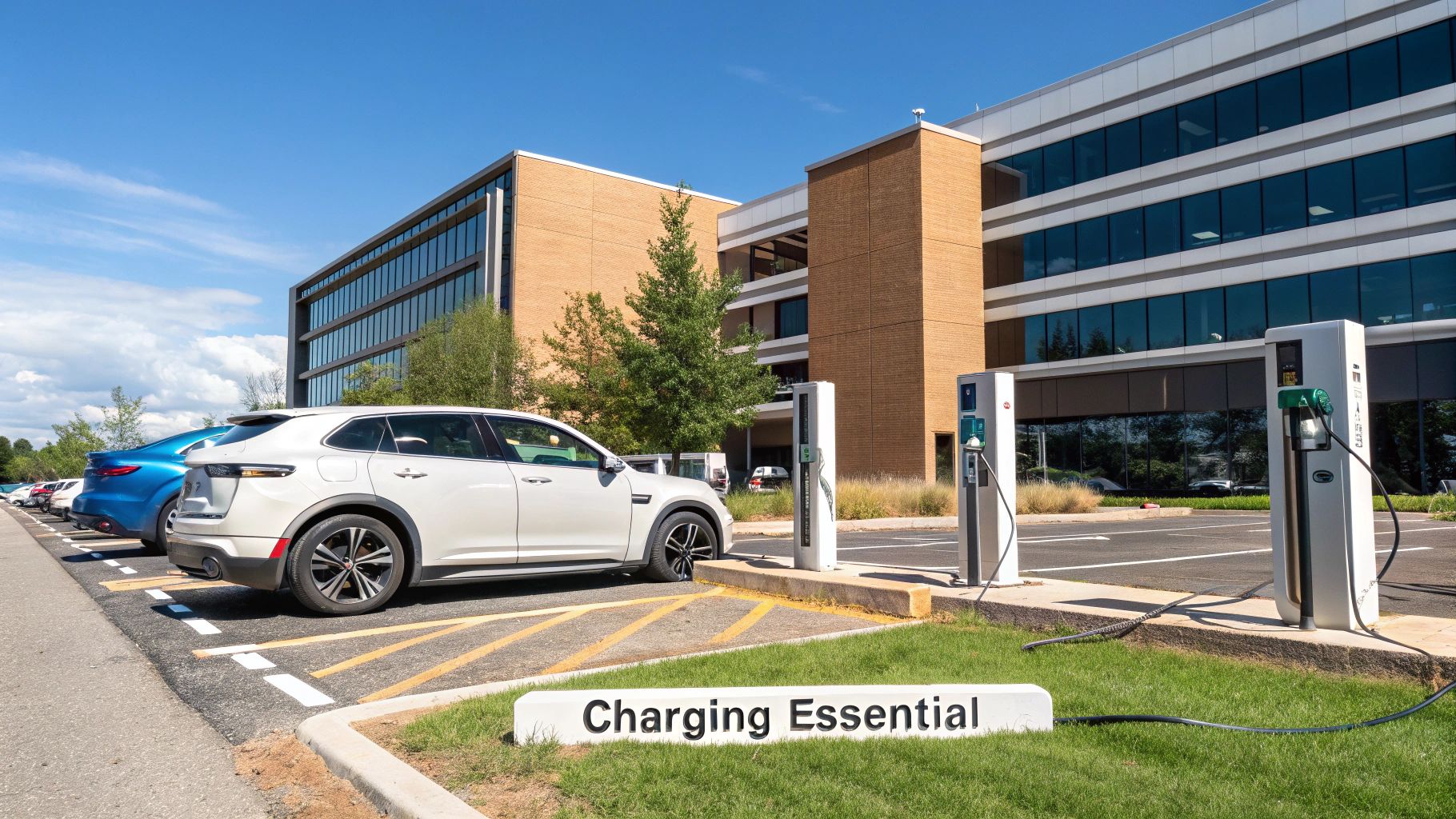
The conversation around workplace EV charging has completely changed. What used to be a novel amenity for a few early adopters is now a critical piece of infrastructure for any forward-thinking UK business. With EV ownership soaring, your employees, clients, and visitors will increasingly expect to find charging points where they work and visit.
Simply put, ignoring this trend is not an option anymore. Businesses that do not adapt risk looking out of touch and disconnected from the priorities of today’s workforce. This is about more than just convenience; it’s about showing you’re genuinely committed to sustainability and your employees' well-being.
Attracting and Keeping the Best People
In a tight job market, the benefits you offer can be the deciding factor. For a growing number of professionals—especially those who are environmentally conscious—having EV charging at work is a huge draw. It is a tangible benefit that supports their lifestyle and reflects their values.
Imagine two identical job offers. One company has reliable EV charging, so an employee can commute and top up their battery without any hassle. The other does not, leaving them to hunt for public chargers that are often busy or expensive. The choice is pretty clear.
We’re seeing this in surveys all the time. Employees with access to workplace charging report much higher job satisfaction. It’s a clear signal that an employer is invested in their staff and the future of green transport.
Providing this facility removes a major headache for current and potential EV drivers, making your company a far more attractive place to work.
Boosting Your Green Credentials
Corporate Social Responsibility (CSR) is more than just a buzzword; it’s a massive part of your company's reputation. Installing EV chargers is a powerful, visible statement that you're serious about cutting carbon emissions and supporting green initiatives.
It is real-world proof that your business is taking practical steps towards a sustainable future. This strengthens your brand image and can be a key differentiator for customers and partners who want to work with environmentally responsible organisations.
A solid workplace charging programme helps you:
- Strengthen CSR: It is tangible proof of your green commitments, perfect for your annual reports and marketing.
- Improve Employee Morale: People feel proud to work for a company that’s actively doing something positive for the environment.
- Build a Positive Public Image: It shows you’re a forward-thinking leader in your industry.
Future-Proofing Your Property
Let’s be practical. Commercial properties with EV charging infrastructure are simply more valuable. As EV ownership becomes the standard, buildings without charging facilities will be at a real disadvantage, likely facing lower occupancy rates and rental values.
By investing in workplace charging now, you're not just meeting today's demand but are getting ahead of the curve. It makes your site more appealing to prospective tenants and keeps it relevant in an increasingly electric world. It is a strategic upgrade that protects your asset's long-term value and shows your business is ready for the future of transport.
How to Assess Your Workplace Charging Needs
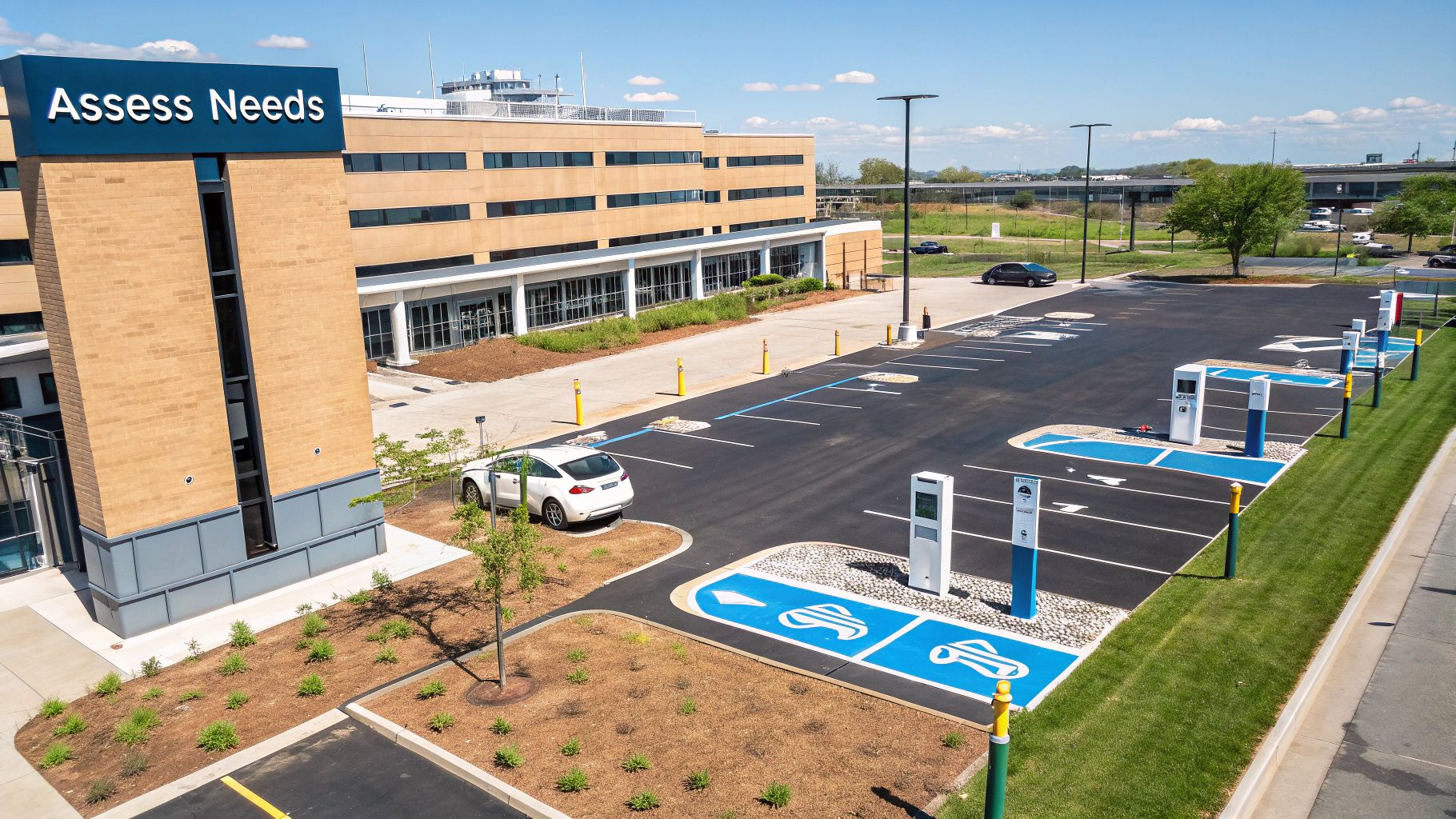
Before you commit to any workplace electric vehicle charging solution, it’s vital to take a step back and get the lay of the land. Rushing into an installation without a clear picture of what you actually need is a fast track to wasted investment and future headaches.
A proper evaluation ensures you land on a solution that fits your budget, your site, and your team's real-world needs. The first port of call is to get a handle on current and future demand from your staff. You cannot build a strategy on guesswork.
Survey Your Employees for Real-World Data
The single best way to gauge demand is to ask your people directly. A simple, anonymous survey can give you a goldmine of information, preventing you from overspending on too many chargers or, just as bad, underserving your team with too few.
Your survey should aim to find out:
- Current EV Ownership: Who is already driving an electric or plug-in hybrid vehicle to the office?
- Future Intentions: How many are planning to make the switch in the next one to two years? This helps you future-proof your setup.
- Typical Charging Habits: Do they mostly charge at home or would they rely on workplace facilities? This tells you if you need chargers for daily top-ups or something more substantial.
- Vehicle Types: Understanding the mix of cars (full EVs vs. plug-in hybrids) helps you figure out the necessary charging speeds and durations.
This data is invaluable. If you find out most of your staff just need a small top-up during the day, standard 7kW chargers might be perfectly fine. But if you have team members with long commutes and no home charging, a faster or more flexible solution is probably needed.
Conduct a Thorough Site Assessment
With your employee data in hand, it’s time to look at the physical space. A site assessment will quickly highlight the practical opportunities and, more importantly, the constraints you're working with.
Start with your car park. Look at the layout, how far the parking spaces are from your main electrical intake, and what kind of disruption an installation might cause. Installing fixed charging points often means digging trenches across the car park for armoured cables, which can be both expensive and a major pain for daily operations.
Next, you absolutely must evaluate your existing electrical capacity. Many commercial buildings, especially older ones, simply do not have enough spare power to handle multiple EV chargers without a costly grid upgrade. An electrician can run a load assessment to tell you exactly how much juice you have to play with.
If your site assessment flags limited grid capacity or shows that installing fixed infrastructure would be prohibitively expensive, that’s a strong signal. It likely means a more agile solution, like a mobile charging service, is a much better fit for you. This approach completely sidesteps disruptive groundwork and costly electrical upgrades.
Choosing the Right Number and Type of Chargers
The final piece of the puzzle is deciding how many chargers you need and what kind they should be. Your employee survey gives you the immediate demand but it’s smart to plan for growth.
The UK electric vehicle charging equipment market is forecast to hit 64,360 units in 2025 , and by 2030, the UK is expected to need around 2.4 million charging units . This is not just a trend; workplace charging is becoming a core part of the national infrastructure.
For a business with plenty of parking and grid capacity, a few fixed 7kW units could be a great starting point. If you go this route, though, do not forget about security. It’s well worth looking into Electric Vehicle security bollards to protect your investment.
On the other hand, if your site has grid limitations or you want a scalable solution without the big upfront cost, a mobile charging service is an excellent alternative. It offers flexibility you just cannot get with fixed posts, delivering charging directly to vehicles wherever they’re parked and bypassing infrastructure hurdles completely.
Securing Grants and Funding for Your EV Chargers
The initial cost of installing workplace electric vehicle charging can feel like a major hurdle. The good news is that there’s a lot of financial support available for UK businesses, and navigating the funding landscape is simpler than you might think. Getting it right can dramatically reduce your upfront investment, turning a potential expense into a smart, subsidised asset.
Most of the primary support comes directly from the UK government. The Office for Zero Emission Vehicles (OZEV) runs the Workplace Charging Scheme (WCS) specifically to help businesses cover these costs. It’s all part of a wider £1.6 billion commitment to build out the UK’s charging infrastructure—something that’s becoming more urgent by the day as EV registrations continue to climb.
Understanding the Workplace Charging Scheme
At its core, the WCS is a straightforward voucher-based system designed to make adding EV chargers more affordable for businesses, charities, and public sector organisations. It gives you a clear pathway to claim back a decent portion of the purchase and installation costs for each charging socket you install.
Here are the key things you need to know:
- Financial Support: The grant covers up to 75% of the total cost of buying and installing the charge points.
- Voucher Value: This support is capped at a maximum of £350 per socket.
- Number of Sockets: You can apply for vouchers for up to 40 sockets in total, spread across all your business sites.
To qualify, your business just needs to have dedicated off-street parking, and the installation has to be done by an OZEV-approved installer. The process is simple: you apply for a voucher online, and once it’s approved, you give it to your installer. They claim the grant on your behalf and just deduct the amount from your final invoice.
Exploring Other Funding Avenues
While the WCS is the best-known grant, it’s not the only financial help out there. I’ve seen many businesses successfully stack different funding sources to bring their costs down even further. It’s always worth taking a look at what’s on offer in your specific local area.
This infographic gives you a good idea of the typical funding sources you might come across.
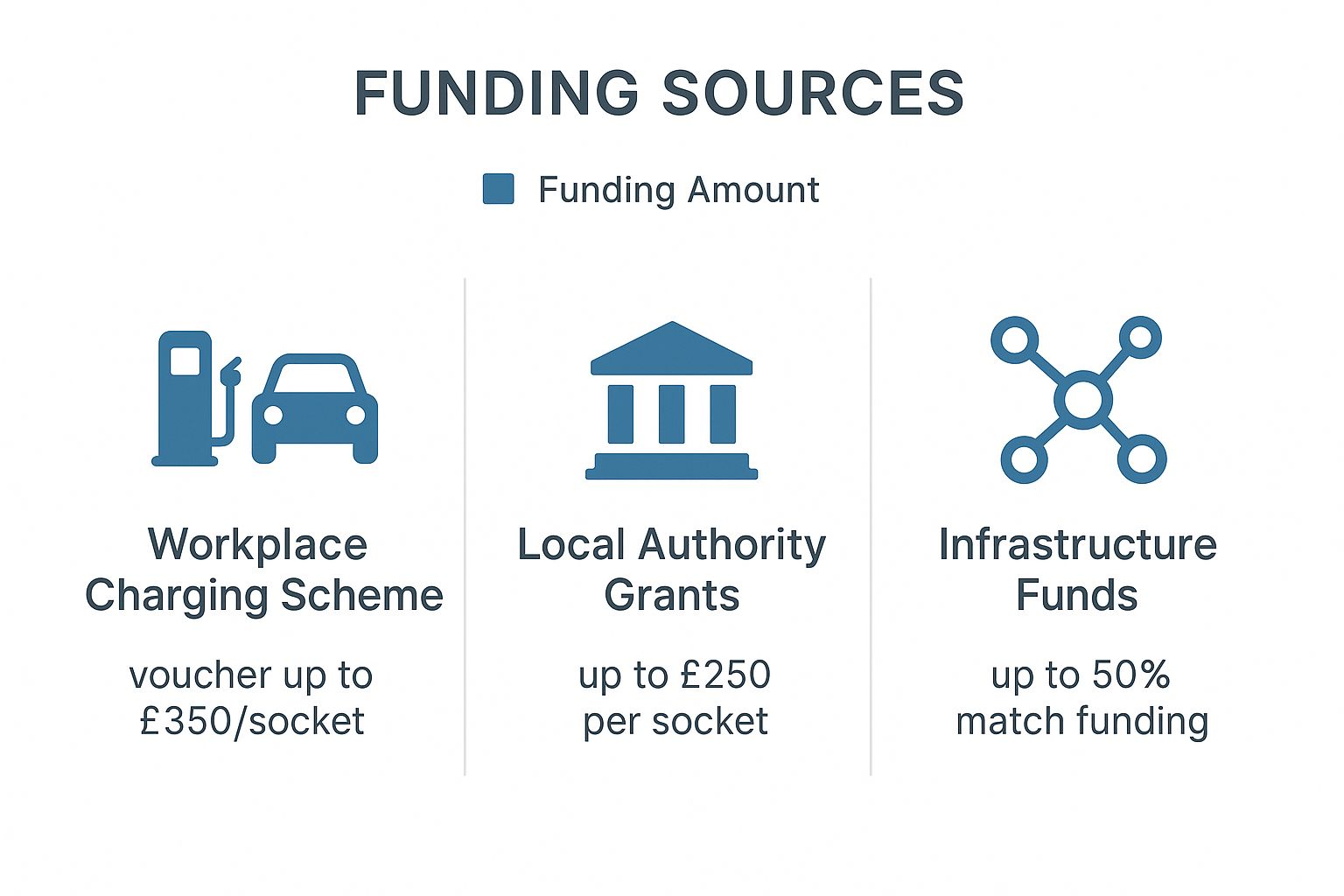
As you can see, combining a national scheme like the WCS with local incentives can make a huge difference to your initial outlay.
Start by looking into local authority grants; many councils offer their own top-up funds to encourage local businesses. It is also a good idea to keep an eye out for larger infrastructure funds, which sometimes offer match funding for projects that line up with regional decarbonisation goals. For a deeper dive into the options available, you might find our guide on finance for EV chargers useful.
One piece of advice: building a strong business case is absolutely essential when you apply for any grant. Clearly outline the demand from your employees, the environmental benefits, and how your project supports wider community goals. This really strengthens your application and boosts your chances of securing the maximum funding.
And do not forget to think beyond direct EV charging grants. Businesses can also find ways to reduce the ongoing energy costs for their new stations. For instance, you could explore the benefits, costs, and incentives of solar panel installation to generate your own clean electricity, which makes the financial return on your investment even better.
Choosing Your Solution: Fixed vs Mobile Charging
So, you’ve done the site assessment and looked into funding. Now comes the big decision: what kind of charging hardware will you actually use? When it comes to workplace electric vehicle charging , you're really looking at two main paths—the traditional fixed charging point or a more flexible mobile charging service.
Each has its place but they solve very different problems. Let's break down which one might be right for you.
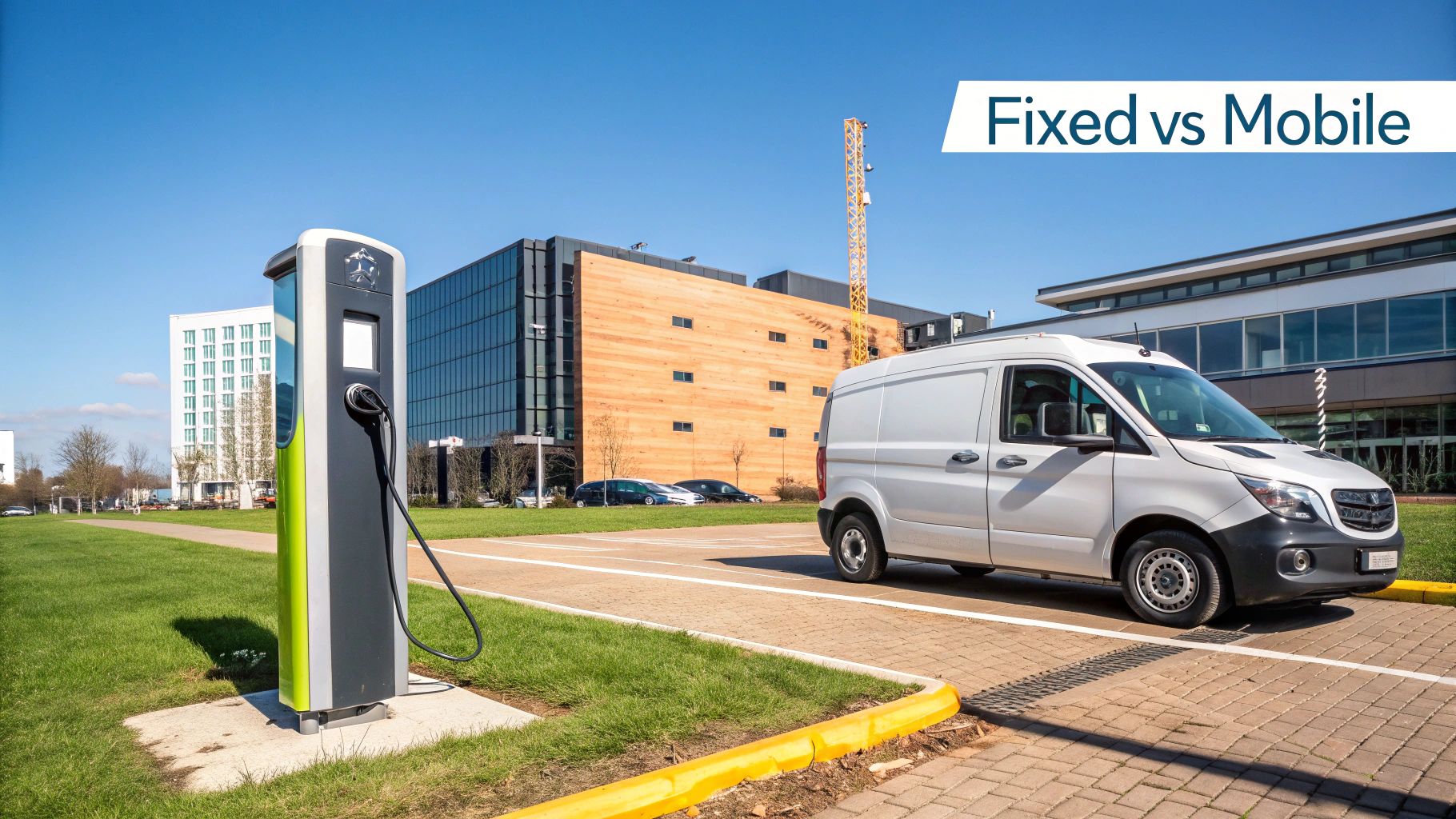
The Case for Fixed Charging Points
Fixed chargers are what most people picture: the familiar wall boxes or posts you see bolted down in car parks. They are a permanent fixture, hard-wired directly into your building’s electrical system. If you have plenty of grid capacity, a straightforward car park layout, and a clear idea of future demand, this can be a solid long-term solution.
But—and it is a big but—the installation is often where the headaches start. It can involve digging trenches, laying armoured cables, and sometimes, a very expensive upgrade to your entire electrical infrastructure. For older buildings or sites with complex layouts, these civil works can be seriously disruptive and costly.
For businesses where the setup is right, fixed chargers offer a reliable "set and forget" option. You’ll typically see 7kW units for staff who need a top-up during the workday or faster 22kW units for quicker turnarounds.
Modern units also come with genuinely useful smart features. Load balancing , for example, is critical. It intelligently distributes available power across multiple chargers to stop your system from tripping when everyone plugs in at once—a very real concern.
The user experience is pretty seamless too. Staff can tap an RFID card or use an app to start charging, and you can manage it all from a central dashboard. For a deeper look at how stationary and mobile solutions stack up, check out our comparison on the future of EV charging.
The Unmatched Flexibility of Mobile Charging
This is where the game really changes. Mobile charging is a breath of fresh air for businesses hitting common roadblocks like grid limitations, tricky site layouts, or the eye-watering cost of groundwork. It works independently of your building's power supply, bringing the charge directly to vehicles wherever they’re parked. This mobility is its greatest advantage.
Think of it as Energy as a Service (EaaS) . A specialised van with a high-capacity battery and charger shows up on-site and provides charging on demand. The advantages here are huge:
- Zero Installation Hassle: It completely sidesteps the need for any disruptive or expensive civil engineering. No digging, no mess.
- Grid Independence: It is the perfect answer for sites with limited electrical capacity, helping you avoid five-figure grid upgrade bills.
- Ultimate Scalability: You can dial the service up or down based on actual demand. You only pay for what you use.
- Ideal for Tricky Locations: It works beautifully for listed buildings, sites with tight leasing restrictions, or any place where permanent installations just are not an option.
This flexibility makes mobile charging a fantastic way to "test the water" and see what the real demand from your team is before you commit to a major capital investment.
Choosing the right EV charging solution involves weighing the permanence and reliability of fixed points against the flexibility and cost-effectiveness of a mobile service.
Comparison of Fixed vs Mobile EV Charging Solutions
| Feature | Fixed Charging Points | Mobile Charging Services |
|---|---|---|
| Installation | Requires significant groundwork, electrical upgrades, and planning. Can be disruptive and costly. | No installation required. Service is deployed on-demand without site modifications. |
| Grid Dependency | Directly connected to and limited by the site's grid capacity. May require expensive upgrades. | Completely independent of the local grid, avoiding capacity issues and upgrade costs. |
| Cost Structure | High upfront capital expenditure (CAPEX) for hardware and installation. Ongoing maintenance costs. | Operational expenditure (OPEX) model. Pay-as-you-go or subscription-based, with no upfront cost. |
| Scalability | Scaling requires installing more units, which involves further cost and disruption. | Highly scalable. Service can be increased or decreased instantly to match real-time demand. |
| Flexibility & Location | Permanent and immovable. Not suitable for listed buildings, temporary sites, or leased properties. | Extremely flexible. Can service any vehicle, anywhere on-site, including complex or restricted locations. |
| Time to Deploy | Can take months from planning and approval to final installation and commissioning. | Can be deployed almost immediately once a service agreement is in place. |
Ultimately, a mobile service offers a way to provide EV charging immediately and without financial risk, making it an ideal starting point for many businesses.
The Financial Upside of a Mobile Model
Beyond solving your own company's needs, running a mobile charging service opens up a massive commercial opportunity. A single mobile charging van can easily service an entire business park, a multi-tenant office building, or an industrial estate, creating a brand new, profitable revenue stream.
By setting up as a mobile charging operator, you are not just solving a problem for one company; you are creating a scalable business. You can charge clients on a per-kWh basis, offer subscription packages for regular users, or add a convenience fee, turning an operational asset into a serious money-maker.
The running costs are predictable—the van, the charger, insurance, and software—while the potential client base is huge and growing every single day. This model flips workplace charging from a facility management cost into a proactive, profitable enterprise.
It also helps your employees save money. Over half of UK BEV users ( 53% ) chose an EV because it costs less to run but many find public charging prohibitively expensive. By offering a cost-effective mobile service, you support your staff while tapping into a ready-made market. You can explore more data on UK EV driver attitudes in the latest Roland Berger report.
The Profitable Business of Mobile EV Charging
While sorting out workplace electric vehicle charging is a great perk for your team, the mobile model opens up a completely different conversation. Instead of treating it as just another facility cost, you can flip the script and turn it into a profitable business venture.
This is where the real opportunity lies. With a mobile charging van, you're not just servicing your own company; you could be serving an entire business park or industrial estate. Suddenly, you’re no longer just a consumer of charging services—you're the provider.
Unpacking the Economics of Mobile Charging
Turning a mobile EV charger into a business is surprisingly straightforward. At its core, you’re selling electricity and convenience at a premium. Your operation buys electricity to fill up the mobile unit's battery (or generates its own with renewables) and then sells that stored energy on-demand to other local businesses and their employees.
The financial model is simple but incredibly effective. You just need to set a price per kilowatt-hour (kWh) that covers your running costs and leaves a healthy profit margin. And because you’re bringing the charge directly to the vehicle, you can justify a higher rate than a fixed public charger that drivers have to hunt down and wait for.
Smart Pricing Structures for Maximum Profit
Your success as a mobile charging operator really hinges on smart, flexible pricing. A rigid, one-size-fits-all approach just will not cut it. A multi-layered strategy, on the other hand, lets you tap into different parts of the market and boost your earnings.
Think about using a mix of these powerful models:
- Pay-Per-kWh: This is the most direct route. You set a price for each unit of energy delivered. For instance, if your electricity costs you 20p/kWh , you could charge clients 50-60p/kWh , which easily covers your overheads.
- Subscription Packages: Offer monthly or annual subscriptions to businesses in your service area. A company could pay a flat fee for a guaranteed number of charging sessions for their staff each month. This gives you predictable, recurring revenue.
- Convenience and Call-Out Fees: Do not forget to charge for the service itself. Adding a small, fixed fee for each charging session covers the sheer convenience of bringing the charger to the car—a service plenty of drivers are happy to pay for.
By combining these models, you can create multiple income streams from a single mobile charging unit.
Calculating Your True Profit Margins
To get a real sense of profitability, you have to weigh your potential revenue against your operational costs. The initial outlay for a van and a high-capacity mobile charger is the main investment but the ongoing costs are actually quite predictable and manageable.
Your main operational costs will include:
- The vehicle itself (whether you lease or buy)
- Insurance for the van and the equipment
- The cost of electricity to charge your mobile unit
- Software fees for the booking and payment platform
- Routine maintenance for the vehicle and charger
Even after you factor all of this in, the profit margins can be substantial. A single van servicing multiple clients in a concentrated area like a business park can generate significant daily revenue. We have put together a detailed breakdown of the numbers in our deep dive into the economics of mobile EV charging.
The key takeaway is this: a mobile charging business has relatively low and predictable overheads compared to its high revenue potential, especially as EV adoption continues to soar. The demand is already there and is only going to grow.
A Real-World Scenario: The Business Park Operator
Picture a multi-tenant business park. It is home to ten different companies and around 200 employees. It’s a classic scenario: many of these businesses do not have the budget or the physical space for fixed chargers. This is a goldmine for a mobile charging operator.
With just one van, you could offer a scheduled service, visiting the park two or three times a week. You could strike deals with each business individually or with the facilities manager for the whole site. Employees book their slots through an app, and you can service dozens of cars in a single day without anyone having to leave their desk.
This table gives a rough idea of the potential monthly revenue you could generate from one van in this kind of setup.
Potential Monthly Revenue for a Mobile Charging Operator
This table provides an example breakdown of potential earnings for a single mobile EV charging van operating in a business park, based on common pricing models and charging demand.
| Revenue Stream | Calculation Example | Estimated Monthly Revenue |
|---|---|---|
| Pay-Per-kWh Sales | 40 charges/week @ 25kWh each @ 55p/kWh | £2,200 |
| Subscription Fees | 5 businesses @ £150/month subscription | £750 |
| Convenience Fees | 160 charges/month @ £2 convenience fee | £320 |
| Total Estimated Revenue | £3,270 |
As you can see, this model shows how quickly a mobile charging service can become a profitable enterprise. You are not just making money; you're providing an essential service, solving a major headache for local businesses, and positioning yourself as a key player in the local EV infrastructure.
Workplace EV Charging: Your Questions Answered
Dipping your toe into the world of workplace electric vehicle charging can feel like opening a can of worms. It’s a smart move for any forward-thinking UK business but it’s natural to have questions about the costs, the logistics, and the day-to-day management.
Let’s tackle some of the most common queries we hear from businesses just like yours.
What’s the Real Cost of a Workplace EV Charger in the UK?
This is usually the first question on everyone's mind and the answer is... it varies. A lot.
For a basic, 7kW wall-mounted charger, you could be looking at somewhere between £1,000 and £1,500 per unit. That is after you have factored in the OZEV Workplace Charging Scheme grant, which helps soften the blow.
But that’s the best-case scenario. If your site needs serious electrical upgrades or you have to dig trenches across a car park to lay cables, the costs can spiral quickly. Suddenly, a simple project becomes a major capital expense.
This is where the numbers start to look very different for a mobile charging service. Instead of a hefty upfront bill, you’re looking at a straightforward service fee or a pay-per-use model. It flips the cost from a capital investment to a manageable operational expense, completely sidestepping those big installation bills.
Can We Actually Charge Our Staff to Use Them?
Yes, you absolutely can, and it’s easier than you might think. Modern smart charging systems—both fixed and mobile—are built with management software that gives you total control over pricing. This means you can shape the service to fit your business goals perfectly.
You could go a few different ways with this:
- Make it a free perk. This is a brilliant way to keep your team happy and makes you look great to potential new hires.
- Aim for cost-neutral. Set a price that covers your electricity, any network fees, and upkeep. The service pays for itself.
- Create a small revenue stream. Price it just above your costs to generate a modest profit for the business.
Having this level of control ensures the service aligns with both your employee benefits package and your financial strategy.
What if Our Building Doesn’t Have the Electrical Capacity?
This is a huge, and very common, roadblock. A site survey might reveal your grid connection simply cannot handle the extra demand from a bank of EV chargers. You could apply for a grid upgrade but be warned: it’s often a painfully slow and eye-wateringly expensive process.
Even smart chargers with 'load balancing' features, which cleverly share power between cars, can only work with the total capacity you have available. They manage the load but they cannot create more power out of thin air.
This is another problem that mobile EV charging just completely solves. Because a mobile service brings its own power source to the site, it’s entirely independent of your building’s electrical supply. It bypasses any grid limitations you have, giving you a solution that can grow with demand instantly, without touching your existing infrastructure.
How Would We Manage Who Uses the Chargers and How They Pay?
Keeping track of usage and payments is handled by clever back-office software. With a fixed installation, you’d typically give your staff RFID cards or have them use a smartphone app to start and stop their charging sessions.
The software takes care of the rest—logging every session, handling the billing if you’re charging for the service, and providing you with detailed reports. It does, however, put the admin burden of managing users and payments squarely on your team's shoulders.
With a mobile charging service, the operator handles all of that for you. They manage the bookings, the user accounts, and all the payment processing through their own dedicated platform. This lifts the entire administrative weight from your business, letting you offer a top-tier charging facility without any of the daily management headaches.
Ready to provide hassle-free, scalable EV charging without the massive upfront cost? ZAPME offers pioneering mobile charging solutions that bypass grid limitations and complex installations. Discover how our Energy as a Service model can benefit your business today at https://www.zapme.biz.

